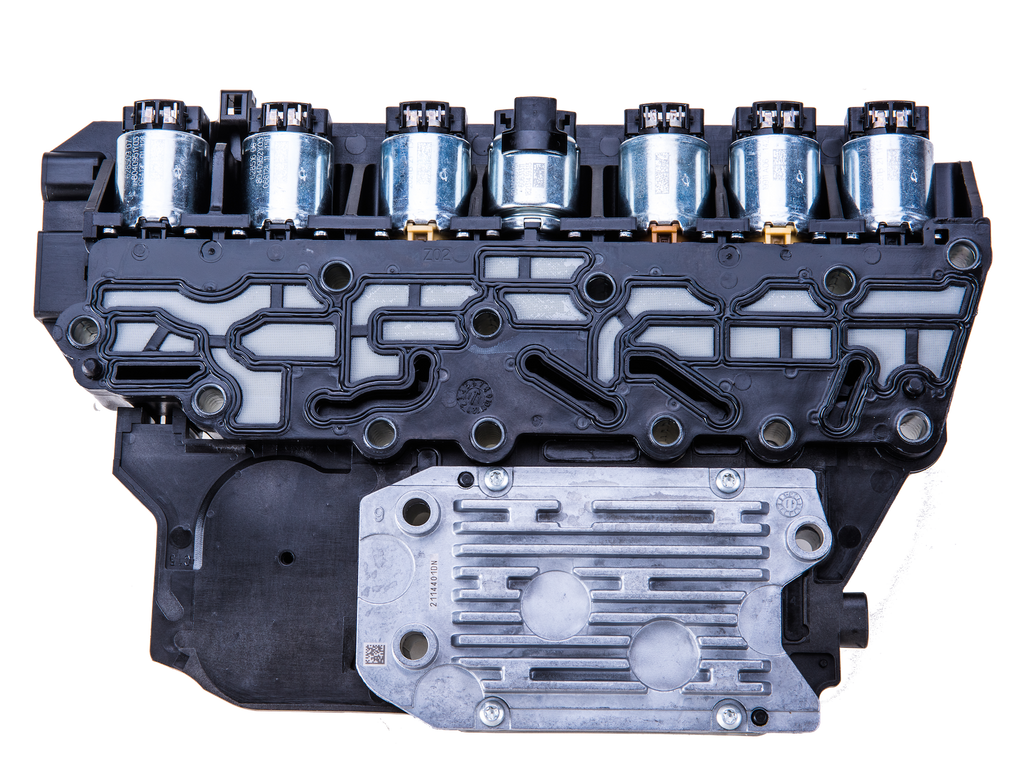Whether on eBay or through a GM parts website, it’s easy to find remanufactured TEHCM for sale. At Berkeley Standard we want to share our process and how our remanufactured 1st generation TECHM is superior to a repaired unit. The most common failure modes for 1st generation 6T40/6T45/6L70 TEHCM are pressure switches, solenoids, and sensor malfunctions. The 2nd generation TECHM was introduced in 2012/2013 and is redesigned to eliminate pressure switches. The 1st and 2nd generation TECHM are paired to different valve bodies are not interchangeable.

TEHCM Remanufacturing Process
- Our TEHCM cores are run through a testing machine that simulates a vehicle in operation. We our test measures oil pressure curves for each of the 6 solenoids and match them against OEM specifications. We run a separate test on each of the 4 pressure switches and measure the oil pressure needed to trigger them.
- After we run our initial tests we disassemble the entire TEHCM. The filter plate is removed and cleaned. The pressure switches are disassembled, cleaned, inspected and tested. The solenoids are usually where we find the most problems. Each solenoid is disassembled and cleaned in solvent before reassembly to completely remove any dirt or blockage from the assembly. Since the magnet within each solenoid attracts metal debris using an ultrasonic cleaner is insufficient. We do more than just fix what’s broken. We disassemble, thoroughly clean and inspect every component of the TEHCM.
- Each component is visually inspected and replaced if damaged. Rubber seals in the solenoids are replaced. We assemble the entire unit and re-run the test from step 1. We fix any component out of spec measurements. Usually this means we replace, repair and recalibrate the solenoids or pressure switches. We iterate and re-test until each individual component and the combined output of the TECHM and valve body matches OEM output specifications.
Dirty solenoids affect performance and must be disassembled to clean and inspect

Testing and repairing faulty pressure switches

Remanufactured
- Remanufactured units are initially diagnosed with a scan tool and disassembled completely. Every sensor, solenoid, and switch is cleaned, tested, and replaced if does not meet OEM specifications.
- Components such as rubber o-rings degrade over time and should be 100% replaced as part of the remanufacturing process
- Testing the remanufactured unit needs to be done over a range of conditions to replicate the operating environment in a vehicle. This requires special equipment to ensure consistency.
- Solenoids in the TECHM have varying output and need to be paired and tested with each TECHM to get the desired output. Simply replacing a worn solenoid with a new one without testing won’t guarantee output within OEM specifications.
- Sensors decay with age and need to be tested across a range of heat, pressure, and time. Sometimes a sensor or switch will read correctly on a cold start but degrade after a few minutes of use
- Remanufactured units guaranteed to meet or exceed OEM specifications and come with a 1-year warranty
Repaired
- Repaired units are diagnosed with a scan tool, and repaired if the problem is a minor one. Faulty sensors and solenoids are cannibalized from TEHCM cores that are too damaged to be cost-effectively repaired.
- Repairs are done on a smaller scale and in a less automated way. There is high-variability between each unit due to varied wear of parts and a less consistent repair process.
- Repaired units are full of worn and dirty components. Disassembling a repaired TECHM will often show problems such as dirt buildup in the solenoids.
- Repaired units should pass a scan tool but these tools can only read sensor data. Knowing whether the unit behaves properly requires more thorough testing with specialized equipment.
You can review our 6T40 TEHCM product